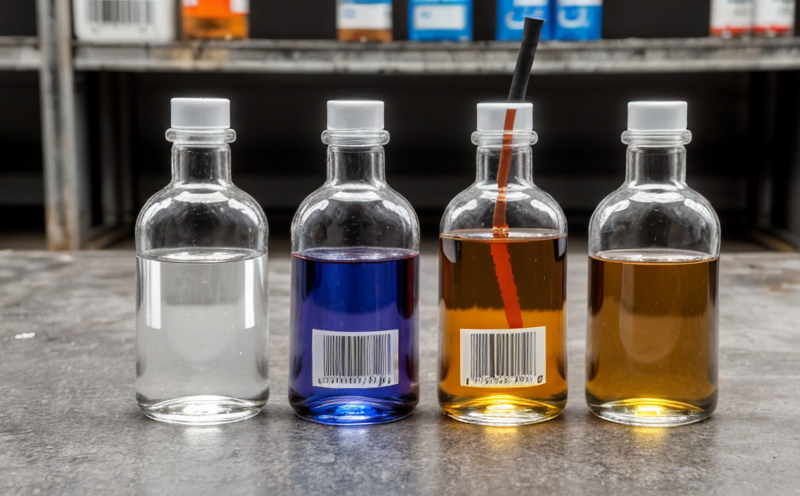BS 3900 Paint and Coating Stability Testing
The British Standard BS 3900 series is renowned for its comprehensive approach to assessing the durability, stability, and performance of paints and coatings. One particular standard, BS 3900-F18:2015, focuses specifically on Paint and Coating Stability Testing. This service evaluates how a paint or coating will withstand various environmental conditions that may lead to degradation over time.
This testing is critical in ensuring the longevity of protective finishes applied across industries such as construction, automotive, marine, and aerospace. By simulating real-world exposure scenarios like UV radiation, temperature fluctuations, humidity, and chemical exposure, this standard helps manufacturers ensure their products meet stringent quality standards before they reach market.
The process involves exposing paint or coating samples to a series of environmental challenges over specified durations. These exposures are designed to mimic the conditions that would be encountered during the product’s lifetime in use. The testing covers both short-term and long-term stability, providing insights into how well the material can resist physical changes like cracking, fading, and loss of adhesion.
BS 3900-F18:2015 is particularly valuable for R&D departments as it allows them to refine formulations early in the development cycle. This ensures that any issues related to stability or performance are identified before costly production runs begin. Additionally, compliance officers can use these results to demonstrate adherence to regulatory requirements and industry best practices.
For quality managers, this service provides a robust framework for monitoring product consistency throughout manufacturing processes. By regularly testing incoming raw materials and final products against this standard, companies can maintain high standards of reliability and customer satisfaction.
The BS 3900-F18:2015 test protocol is based on international best practices documented in ISO and ASTM guidelines. The apparatus used includes specialized chambers capable of replicating different environmental stressors. Specimen preparation involves applying the paint or coating to substrates according to specific dimensions, then exposing these samples to controlled environments.
During testing, parameters such as color retention, gloss preservation, adhesion strength, and flexibility are monitored closely. Acceptance criteria vary depending on the intended use of the material but generally aim for minimal changes in appearance and performance after exposure periods ranging from a few days up to several months.
The outcome of this testing is typically reported through detailed reports that outline all conditions under which samples were exposed, observed changes, and whether they met predefined success criteria. These findings are crucial inputs into ongoing product development efforts aimed at enhancing durability and aesthetic appeal.
In summary, BS 3900-F18:2015 is an essential tool for ensuring that paints and coatings maintain their integrity throughout their lifecycle. Its rigorous approach to stability testing provides valuable data which can inform design decisions, support compliance initiatives, and enhance overall product quality.
Industry Applications
| Industry Sector | Description of Application |
|---|---|
| Construction | Evaluating exterior paints and coatings for durability in harsh weather conditions. |
| Automotive | Testing automotive finishes to ensure resistance against UV rays and temperature extremes. |
| Marine | Assessing the performance of anti-corrosion paints under saltwater exposure. |
| Aerospace | Determining how aerospace coatings withstand extreme conditions like high temperatures and chemical exposure. |
The results from BS 3900-F18:2015 play a pivotal role in these sectors by providing reliable data that helps manufacturers develop products capable of performing optimally under various environmental stresses. This ensures not only longer product lifecycles but also improved safety and efficiency.
Quality and Reliability Assurance
The BS 3900-F18:2015 test is integral to a company's quality assurance program. It allows manufacturers to identify potential weaknesses in their products early on, thereby preventing costly recalls or performance failures later down the line. By adhering strictly to this standard during production and post-production phases, companies can build trust with customers who value reliability above all else.
From an R&D perspective, these tests serve as a valuable benchmark against which new formulations can be compared. They help engineers fine-tune their recipes based on real-world performance data rather than relying solely on theoretical models or laboratory experiments that might not fully capture the complexities of actual usage scenarios.
In terms of compliance, meeting BS 3900-F18:2015 ensures adherence to relevant regulations and industry standards. This is particularly important for companies operating internationally where different countries have varying requirements regarding product performance and safety.
Competitive Advantage and Market Impact
Adopting BS 3900-F18:2015 provides significant competitive advantages. It enables companies to offer products that are not only more durable but also more environmentally friendly due to reduced waste from premature failure. This translates into lower maintenance costs for end users and less environmental impact associated with frequent repainting or replacement.
From a marketing standpoint, boasting compliance with this standard can be a powerful selling point. It reassures potential clients about the quality of your offerings while differentiating yourself from competitors who may not have made similar investments in research and development.





